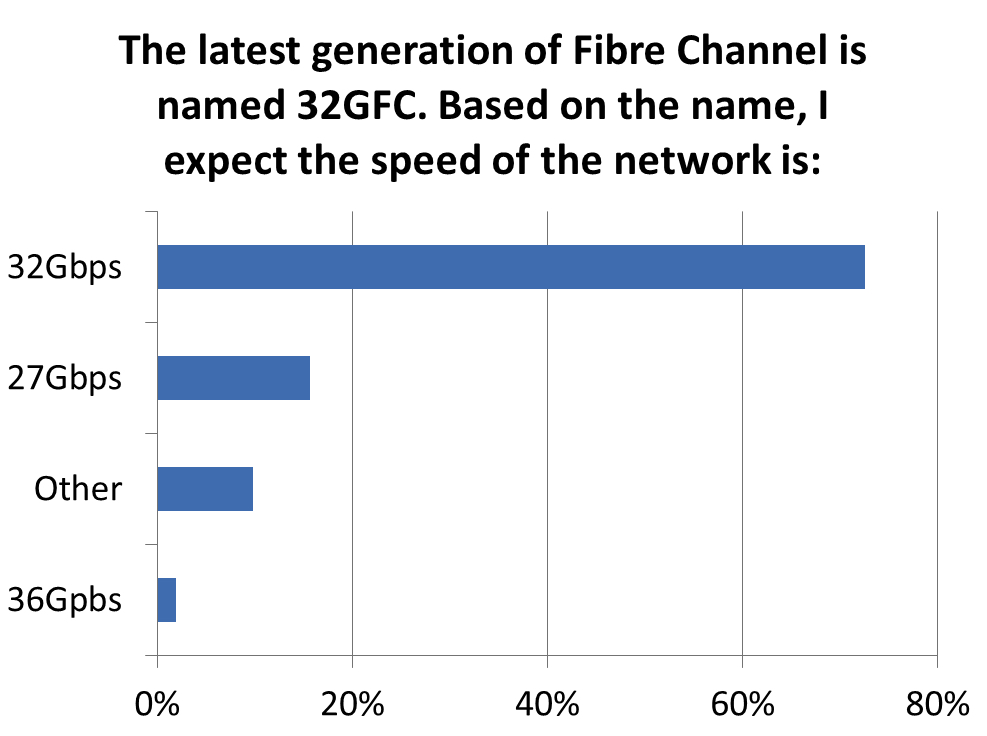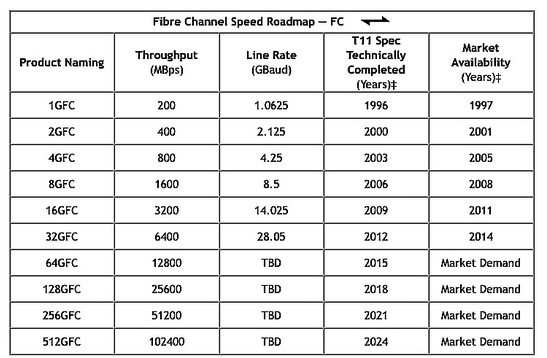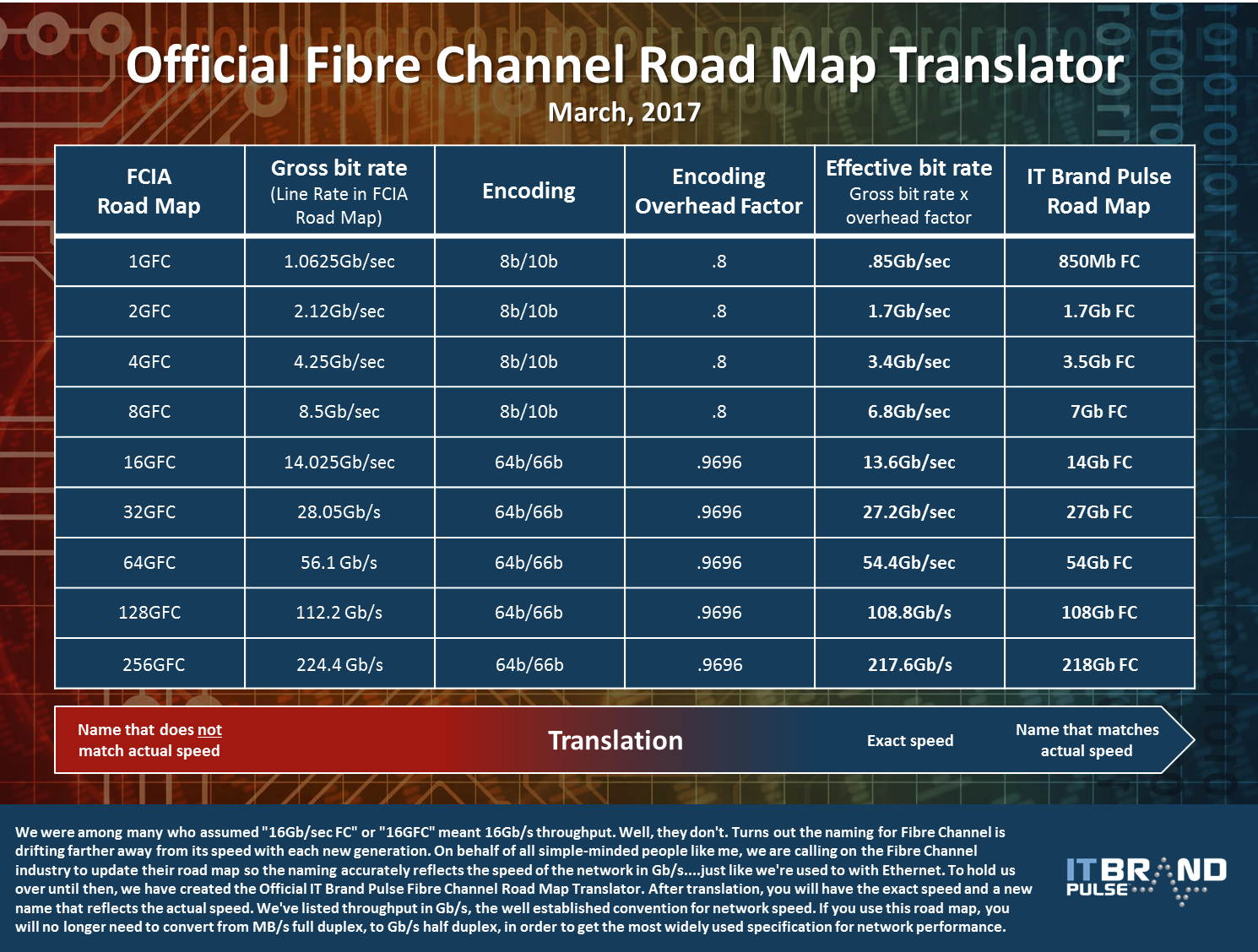FC Naming Should Match Its Performance – IT Brand Pulse
Survey of IT professionals about disparities in FC product naming
This is a Press Release edited by StorageNewsletter.com on March 9, 2017 at 2:51 pmIT Brand Pulse, a source for research, data and analysis about data center infrastructure, released the results of its independent survey of IT professionals which asked respondents about the disparities in FC product naming.
The network technology named 10GbE means throughput is 10Gb/s, and if you’re like most people, you would naturally believe the network called 32Gb FC, means throughput is 32Gb/s. The reality is the name matches the speed for Ethernet, but surprisingly not for FC. The speed of the network is less than the names for each generation of FC.
If you care to know how many people were aware of this, how we got here, what IT pros think should be done, and what the industry is going to do about it, continue reading.
Who Knew FC Names Don’t Match Speed
After talking to several FC industry insiders, the report discovered it’s common knowledge that actual FC speed doesn’t match the number in the name. The next step was to measure awareness of the disparity in the IT community. IT Brand Pulse conducted an independent, non-sponsored survey of 200 IT pros, and not surprisingly, the vast majority expected the name 32Gb FC meant the speed of FC is 32Gb/s.
How This Happened: Speed-Based Naming Is A Baudy Affair
Turns out since the technology was introduced, FC went through periods where it was named after its baud rate, followed by the current time frame where FC naming is ‘generation-based.’
After the dial-up modem industry faded away, FC alone carried the flag of using baud rate as their reference point for naming. What should be used to identify each new generation of FC, is a well established convention: half-duplex throughput in Gb/s. You can arrive at that number by multiplying the baud rate by a factor for encoding overhead. Using Gbaud for naming is, best-case, confusing and somewhat irrelevant. Worst case, it is deceptive.
During the time this 2008 road map was published, the product name was based on the line rate (Gbaud) specification. However, if you multiply Gbaud x the encoding overhead factor, you arrive at the effective throughput number (and name) which is apples-to apples with Ethernet naming. That means 1Gb FC was actually 850Mb FC, and the technology entered the gigabit age at 2Gb FC, which is actually 1.7Gb FC. Clearly the ‘product’ specifications in the chart are confusing or deceptive.
Generation-Based Naming
At 8Gb FC, the naming in the generation-based FC roadmaps was changed to 1Gb FC, 2Gb FC, 4Gb FC, etc. Oddly, the entire SAN industry referred to the technology in terms of Gb/s, yet there was no mention of that specification in the speed roadmap.
The intention isn’t clear with this approach, but results seem very clear:
- Result #1: the vast majority of people interpret the names of each generation of FC as network throughput, when they are not.
- Result #2: the market makes the easy translation to throughput (the higher number)
- Result #3: the industry has plausible deniability, but many customers are misled.
Click to enlarge
It is common for vendors and industry organizations to drop the Gen 5/Gen 6 naming convention and misrepresent the technology as 8Gb, 16Gb FC, etc.
It Matters to the IT Community
Next, IT Brand Pulse asked IT professionals what they thought of this dilemma. About two-thirds of the respondents answered, “Not a big deal, but the FC industry should update their roadmap…” However, the industry should take notice that almost a quarter of the respondents think, “This is a big deal, we have been deceived for a long time…”

Over 80% of IT professionals surveyed said the FC roadmap should be fixed.
The Gap is Growing
This was not much of an issue is when the naming logic was ‘close-enough’ at 1Gb FC and the difference between name and speed was .15Gb/s. But at 32Gb FC, the gap is almost 5Gb/s, and it’s snow-balling.
On behalf of IT community, I’m calling on the FC industry to update their roadmap so the naming accurately reflects the speed of the network in Gb/s … just like we’re used to with Ethernet. To hold us over until then, IT Brand Pulse has created the Official FC Road Map Translator.
As you can see below, we have taken the liberty of renaming each generation and re-introduced ‘Gb’ in the name. By looking at the name, users can easily make an apple-to-apples comparison with Ethernet. I’ve also listed throughput in Gb/s, the well-established convention for network speeds. By using this road map, you will no longer need to convert from MB/s full-duplex to Gb/s half-duplex, in order to get the most widely used specification for network performance.
One of the most interesting data points is that 32Gb FC is actually 27Gb FC; more of a head-to-head competitor with 25GbE than previously thought.
In Industry Organizations We Trust
The networking industry is a highly-competitive arena with tens of billions of dollars on the table. In spite of the high stakes and intense competition, the industry organizations that document standards and specifications have earned our trust by publishing accurate information about FC, Ethernet and IB. Traditionally, it’s been left to vendor product marketing teams to add spin to the basic specifications in the industry road maps
A shout-out to the FC industry to take a serious look at this. If not, we look forward to getting lots of views on the Official FC Road Map Translator in the months and years ahead.

















 Subscribe to our free daily newsletter
Subscribe to our free daily newsletter

